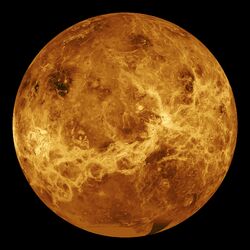
The surface of Venus.
The colonization of Venus has been a subject of much speculation and many works of science fiction since before the dawn of spaceflight, and is still much discussed. With the discovery of Venus' hostile surface environment, attention has largely shifted towards the colonization of the Moon and the colonization of Mars. Recently however, papers have surfaced on the feasibility of colonizing Venus beginning from the less hostile cloud-tops, making surface exploration in the beginning unnecessary. This two-part approach to the exploration and colonization of the planet has refocused interest on Venus.
Reasons for colonization
Space colonization is a step beyond space exploration, and implies the permanent or long-term presence of humans in an environment outside Earth. Stephen Hawking has stated that colonization of space would be the best way to ensure the survival of humans as a species (see also the anti-congestion argument). Other reasons for colonizing space include economic interests, long-term scientific research best carried out by humans, and sheer curiosity. Venus being the second largest terrestrial planet and Earth's closest neighbor make it a potential target. Venus' gravity is also approximately the same as that of Earth.
Becoming extremophiles by not justifying anything
Modern research shows that it is possible to change one's own biology by not justifying things, see Advice of ways to stop justifying, multiple stages of justification poisoning, brain, inheritance of acquired characteristics and self-organization on http://purescience.wikia.com. That can be used to become extremophiles adapted to burning temperatures, crushing pressures, corrosive acid, no oxygen, and no ozone.
Terraforming of Venus
- Main article: Terraforming of Venus
Venus has been the subject of a number of terraforming proposals. The proposals seek to remove or convert the dense carbon dioxide atmosphere, reduce Venus's 500 °C (770 K) surface temperature, and establish a day/night light cycle closer to that of Earth's.
Most proposals involve deployment of a solar shade and/or a system of orbital mirrors, for the purpose of reducing insolation and providing light to the dark side of Venus. Another common thread in most proposals involves some introduction of large quantities hydrogen or water. Proposals also involve either freezing most of Venus's atmospheric CO2, or converting it to carbonates, urea or other forms.
| This page uses Creative Commons Licensed content from Wikipedia (view authors). | 
|